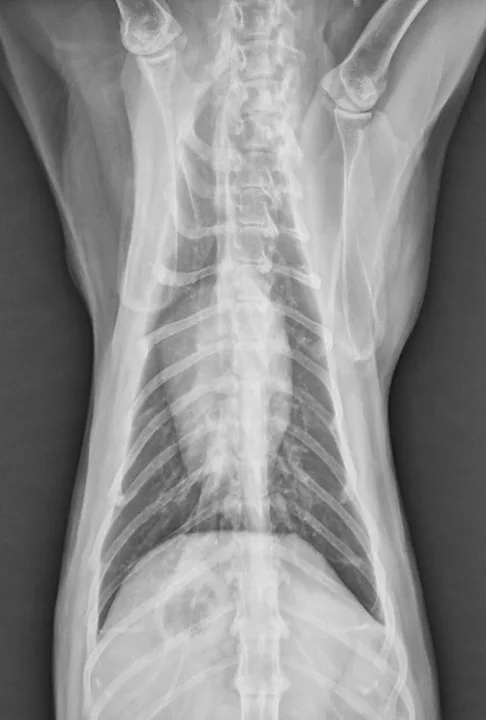Pulmonary Neoplasia & Digital Metastasis in Cats
Andy H. Abbo, DVM, MS, DACVIM (Oncology), Veterinary Cancer Specialists of New England

YOU HAVE ASKED...
What do I need to know about primary lung cancer and digital metastasis in cats?
THE EXPERT SAYS...
Primary Lung Tumors & Metastasis
Primary lung cancer in domestic cats is rare, with <1% of all cancers diagnosed in cats1; however, metastatic cancer of the lungs is more common.2 No incidence data have been reported.

Lateral thoracic radiograph of a 14.5-year-old male domestic cat with a caudal dorsal cavity primary lung mass. Image courtesy of Rachel Moon, DVM, DACVR

Dorsoventral radiograph of right-sided caudal primary lung tumor. Image courtesy of Rachel Moon, DVM, DACVR
Reported primary lung tumors (Figures 1 and 2) include squamous cell carcinoma and sarcoma, but adenocarcinomas are reportedly the most common histopathologic diagnosis.2 Adenocarcinomas are subcharacterized by location (ie, bronchial, bronchioloalveolar, alveolar) and grade. Carcinomas are graded on histopathology as differentiated or undifferentiated, with the grade directly correlating with metastatic incidence.1,3 Although most primary carcinomas are localized and solitary at diagnosis,1,4 the literature suggests that >50% of undifferentiated carcinomas and 90% of squamous cell carcinomas metastasize,1,3 with one study reporting ≈75% of feline lung tumors as metastatic.4 Metastasis to the lungs, skin, CNS, and digits may occur transpleurally, hematogenously, or via lymphatics or airways.1,3,4
Feline Lung-Digit Syndrome
Feline lung-digit syndrome, a syndrome of multiple digital metastasis, is characterized by disseminated metastasis to the digits and is most commonly associated with bronchial and bronchioloalveolar carcinomas.1,3,5,6 This pattern of metastasis is most frequently diagnosed in older cats (mean age, 12 years; range, 2-20 years5), with no consistently reported breed or sex predilection.1,3-6 The pathogenesis is not well-understood; metastatic lesions are believed to arise via arterial embolization from the tumor.5,6 Tumor metastases are located at atypical sites, most notably the distal phalanges (Figure 3), with the weight-bearing third phalanx of the front feet most frequently affected.6 In addition, multidigit and multilimb involvement are common.6,7

Dorsoventral radiograph revealing lytic lesions associated with distal phalanges consistent with digital metastasis. Image courtesy of Rachel Moon, DVM, DACVR
Clinical Examination
Patients may be presented with a history of nonweight-bearing lameness; a painful, firm swelling on the toe; purulent inflammation; and erythema associated with the digit and nail bed.1,4 This clinical presentation is more similar to inflammatory pododermatitis than to a neoplastic condition,5 and histopathology may be needed to make an accurate diagnosis.
Radiographs may reveal extensive osteolysis of the distal phalanx that may cross the joint space. Thoracic radiographs often show a single primary lung mass, although diffuse nodular disease has also been noted.1 No clinical signs of respiratory distress in affected cats have been reported.6
The literature suggests that >50% of undifferentiated carcinomas and 90% of squamous cell carcinomas metastasize.1,3
Treatment & Prognosis
Treatment for lung-digit syndrome is considered palliative, and prognosis is poor. In one study, the median disease-free interval was 24 days, and median survival time was 104 days.7 Another study reported a mean survival time of 58 days after presentation.8
Excision of the affected digit may help alleviate pain and discomfort; however, microscopic metastasis to other digits or locations are likely already present,4,5 limiting the effectiveness of this approach beyond that of palliation. Resectioning the primary lung tumor will not improve the condition of the digits; the mainstay of palliative and/or hospice therapy for affected cats consists of analgesia, supportive care, or radiation therapy with palliative intent.1,4,5 NSAIDs (eg, piroxicam 0.3 mg/kg PO q24h9) may be beneficial because of their analgesic and anti-inflammatory effects, as well as their cyclooxygenase-2 related antiangiogenic effects, which may slow disease progression.10 When using NSAIDs, renal, hepatic, and GI function should be closely monitored to avoid toxicity issues. Buprenorphine, a partial µ-agonist (0.01-0.02 mg/kg PO q8-12h), or tramadol (1-2 mg/kg PO q12h) may also have palliative benefits.11 There are no reports in the veterinary literature of chemotherapy’s efficacy in the management of this syndrome.
Conclusion
Digital metastasis is a rare and painful syndrome that occurs secondary to primary lung tumors in cats. Prognosis is typically poor. Therapy should be aimed at controlling pain.